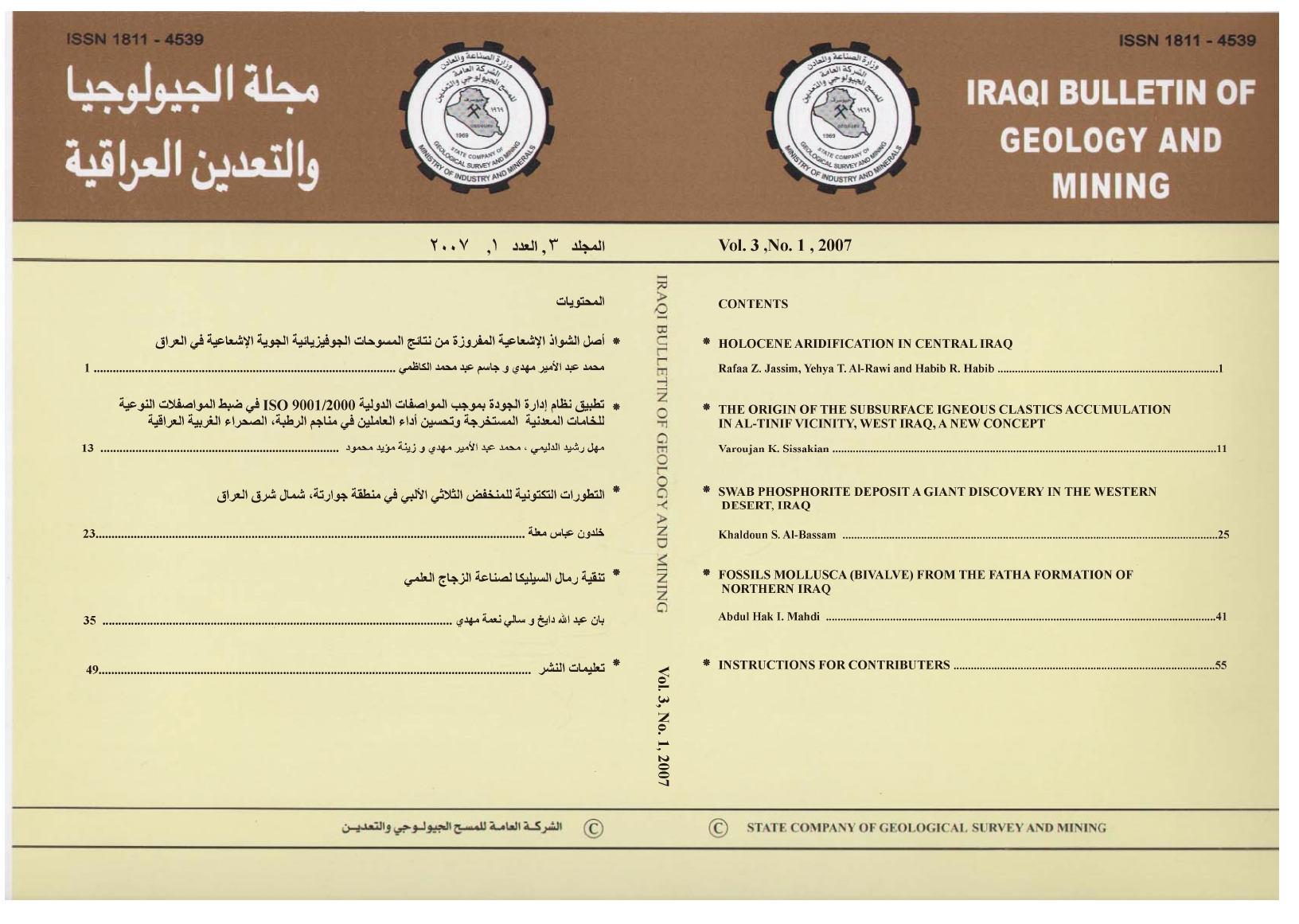Abstract
Shari Playa is a closed basin located in central Iraq and characterized by the development of clastic and saline sediment facies during the last (6000 ــ6500) years. The present climate in the area is semiarid with a mean annual precipitation of about 150 mm and a mean annual temperature of 22°C. The palynomorph constituents of the Shari Playa sediments revealed climatic changes towards dry periods. These palynomorphs include: Tricolpate, Lycopodium, Artemisia, Armeria martima, Palmaepollenites, Chenopodiacea, Graminae, Caryophyllaceae, Lavigatosporites, Quercus, Alnus-Pollenites, Retitriporites, Polygonium, Convolvollus and Centaurea.
Six palaeoecological zones are suggested by the pollen diagram of these sediments. Two wet episodes (Zones 2 and 5) are indicated at (5200 5800) years and (2500 4200) years B.P. The rest zones represent dry and transitional episodes. The predominance of Chenopods in the uppermost zone indicates the climatic deterioration and aridification in the area leading to the present climate.
Six palaeoecological zones are suggested by the pollen diagram of these sediments. Two wet episodes (Zones 2 and 5) are indicated at (5200 5800) years and (2500 4200) years B.P. The rest zones represent dry and transitional episodes. The predominance of Chenopods in the uppermost zone indicates the climatic deterioration and aridification in the area leading to the present climate.
Abstract
مملحة الشارع حوض مغلق في وسط العراق يتصف بوجود سحنات الرسوبيات المنقولة والترسبات الملحية خلال فترة ( (6500 6000 سنة المنصرمة. المناخ الحالي في المنطقة شبه جاف ويكون معدل سقوط الأمطار فيه حوالي 150 ملم سنوياً ومعدل درجات الحرارة السنوي حوالي 22 °م. يظهر محتوى ترسبات المملحة من حبوب الطلع والسبورات تغيراً في المناخ تسوده فترات من الجفاف. وقد تواجدت حبوب الطلع والسبورات بنسب مختلفة تبعاً لطبيعة المناخ وتمثلت ب:
Tricolpate, Lycopodium, Chenepodiacea, Palmaepollenites, Armeria martima, Artemisia, Quercus, Lavigatosporites, Caryophyllaceae, Graminae, Centaurea, Convolvollus, Polygonium, Retitriporites and Alnus-Pollenites.
تم اقتراح ستة أنطقة حياتية قديمة اعتماداً على مخطط محتوى حبوب الطلع والسبورات في هذه الرسوبيات وقد أمكن تمييز فترتين مطيرتين (النطـاقين 2 و5) تمثلتا بالفترتين (5200 ـ (5800 سنة و 2500) ـ (4200 سنة من الآن. أما باقي الأنطقة فقد مثلت فترات جافة وانتقالية. إن وجود نسبة عالية من Chenopods في النطاق العلوي يشير إلى التردي في المناخ والتصحر في المنطقة مفضياً إلى المناخ الحالي.
Tricolpate, Lycopodium, Chenepodiacea, Palmaepollenites, Armeria martima, Artemisia, Quercus, Lavigatosporites, Caryophyllaceae, Graminae, Centaurea, Convolvollus, Polygonium, Retitriporites and Alnus-Pollenites.
تم اقتراح ستة أنطقة حياتية قديمة اعتماداً على مخطط محتوى حبوب الطلع والسبورات في هذه الرسوبيات وقد أمكن تمييز فترتين مطيرتين (النطـاقين 2 و5) تمثلتا بالفترتين (5200 ـ (5800 سنة و 2500) ـ (4200 سنة من الآن. أما باقي الأنطقة فقد مثلت فترات جافة وانتقالية. إن وجود نسبة عالية من Chenopods في النطاق العلوي يشير إلى التردي في المناخ والتصحر في المنطقة مفضياً إلى المناخ الحالي.
